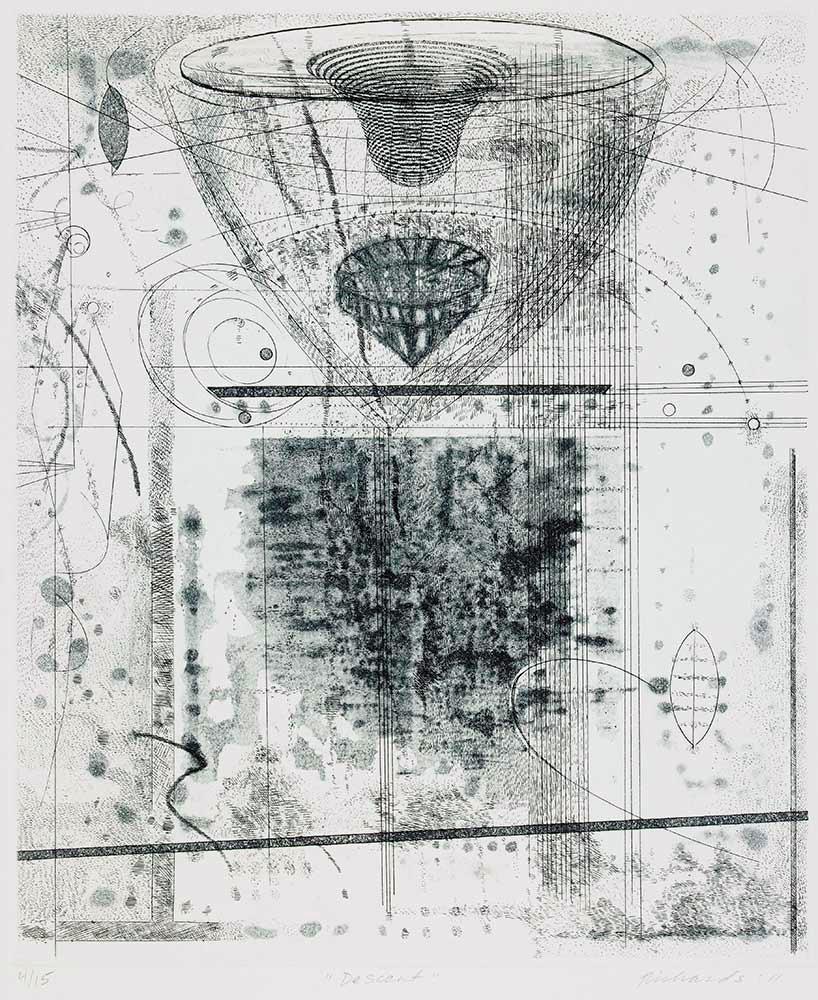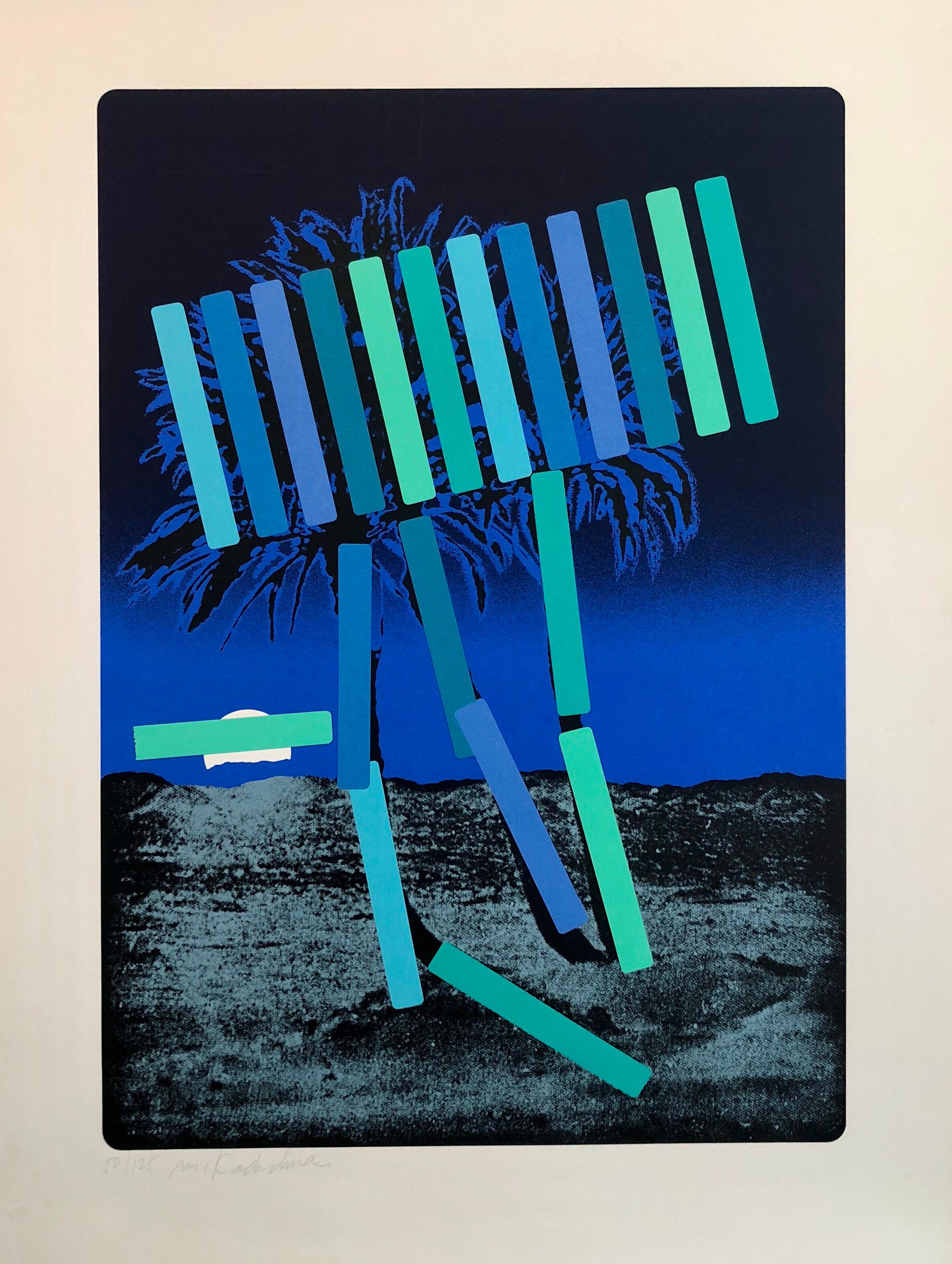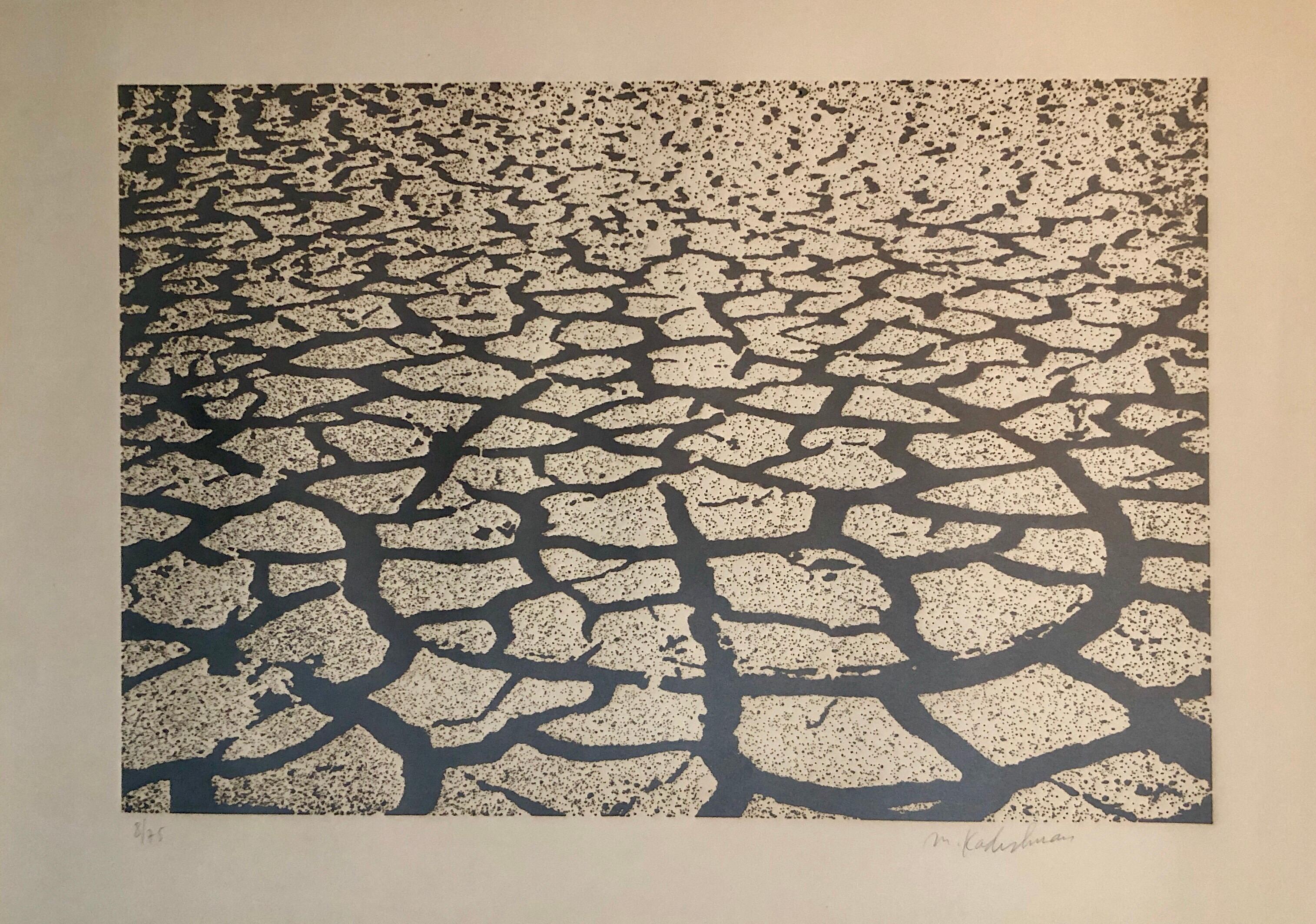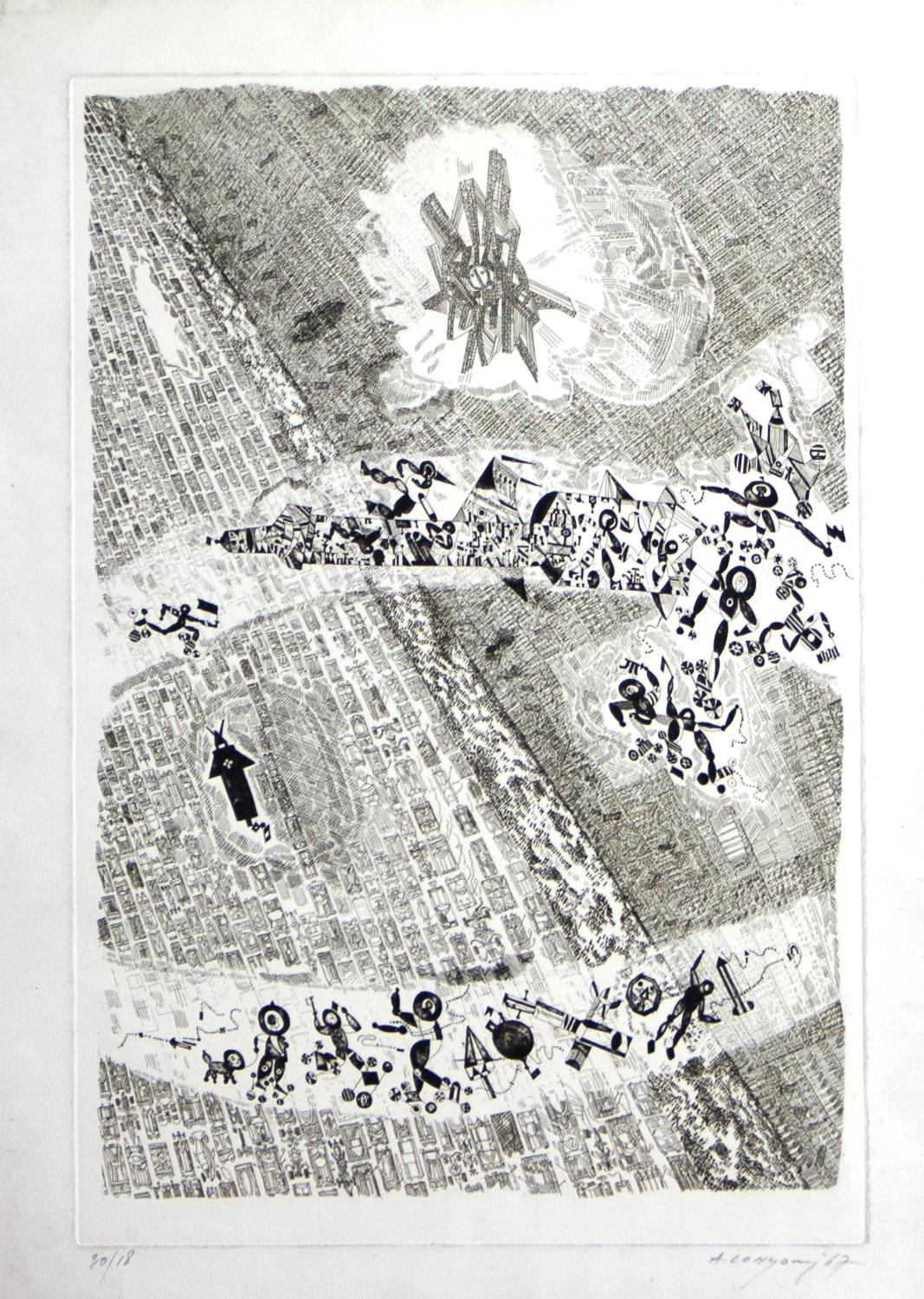Items Similar to Indistinct Clear - Fluctuating ambivalence -
Want more images or videos?
Request additional images or videos from the seller
1 of 8
Karl MordsteinIndistinct Clear - Fluctuating ambivalence -1982
1982
About the Item
Karl Ludwig Mordstein (1937 Füssen - 2006 Wilszhofen), Undeutlicher deutlich, 1982. Color etching, e.a. (Epreuve d'artiste) 4/9, 22.5 x 28 cm (image), 40 x 45 cm (sheet), 43 x 48 cm (frame), titled, numbered, monogrammed and dated with pencil. Framed behind glass.
- in very good condition
- Fluctuating ambivalence -
About the work
The print is titled "Indistinct Clearly," and indeed we think we see something clearly that remains indistinct. We see an image divided by color into two zones, evoking a landscape space with a horizon line. Within this landscape, there is a kind of whirl of fragile brown elements that are clearly in front of our eyes, but cannot be visually resolved. What is happening remains a mystery, especially since a fragile structure, typical of Mordstein's graphic work at the time, appears in the left area below the flurry. It is also clearly recognizable, but the clarity only leads to increased ambiguity. It is precisely this ambivalence of clarity that Mordstein presents as a visual experience.
About the artist
After graduating from the Werkkunstschule in Augsburg, Karl Mordstein worked as a commercial artist in Munich before becoming a freelance artist and concentrating entirely on his own creations. In 1970 Mordstein married the sculptor Sinen Thalheimer and the artist couple moved to Starnberg. In 1972, Mordstein had his first solo exhibition in Munich, which marked the beginning of an active international exhibition career that lasted for decades. From 1987 the couple lived on the Hollerberg in Wilzhofen.
“It is certainly not wrong to recognize in the impression of his calmly floating color drawings the expression of a state of mind that owes itself precisely to this conscious turning away from the hectic art market: concentrated serenity. It is not a changing state of mind, but an empathy with the supra-individual rhythms of creation, the perpetual genesis in the natural cycle of becoming and passing, which is expressed in them.”
- Stefan Tolksdorf
Selected Bibliography
Karl Mordstein. Aquarelle, Gouachen 1972 – 1975, Galerie Angst und Orny, München 1975.
Juliane Roh: Karl Mordstein. Bilder, Paintings 1976 – 79, Frankfurt a. M. 1979.
Siegfried Salzmann (Text): Karl Mordstein. Arbeiten auf Papier, Galerie Dorothea van der Koelen, Mainz 1982.
Galerie Heimeshoff (Hrsg.): Karl Mordstein. "Seelen-Notate"; Bilder, Arbeiten auf Papier, Bildkästen; 1985 – 1988, Essen 1988.
Stefan Tolksdorf (Text): Lebenszeichen. Mordstein, Karl und Sinen Thalheimer, Essen 2009.
GERMAN VERSION
Karl Ludwig Mordstein (1937 Füssen – 2006 Wilszhofen), Undeutlicher Deutlich, 1982. Farbradierung, Exemplar e.a. (Epreuve d'artiste) 4/9, 22,5 x 28 cm (Darstellung), 40 x 45 cm (Blattgröße), 43 x 48 cm (Rahmen), in Blei betitelt, nummeriert, monogrammiert und datiert. Hinter Glas gerahmt.
- in sehr gutem Erhaltungszustand
- Fluktuierende Ambivalenz -
zum Kunstwerk
Die Grafik ist mit „Undeutlicher deutlich“ betitelt und tatsächlich meinen wir etwas deutlich zu erkennen, das doch undeutlich bleibt. Wir sehen ein farblich in zwei Zonen geteiltes Bild, das einen Landschaftsraum mit Horizontlinie evoziert. Innerhalb dieser Landschaft ist eine Art Gestöber fragiler brauner Elemente im Gange, dass uns zwar klar vor Augen steht, sich visuell aber nicht aufschlüsseln lässt. Was sich ereignet bleibt rätselhaft, zumal im linken Bereich unter dem Gestöber eine für Mordsteins Grafikern dieser Zeit typische fragile Struktur sichtbar wird. Auch sie ist deutlich zu erkennen, doch führt die Deutlichkeit einzig zu einer erhöhten Undeutlichkeit. Eben diese Ambivalenz der Deutlichkeit führt Mordstein als Seherlebnis vor Augen.
zum Künstler
Karl Mordstein absolvierte die Werkkunstschule Augsburg und war zunächst in München als Gebrauchsgraphiker tätig, bevor er sich als freier Künstler ganz auf seine eigenen Schöpfungen konzentrierte. 1970 ehelichte Mordstein die Bildhauerin Sinen Thalheimer und das Künstlerpaar zog nach Starnberg. 1972 fand in München eine erste Einzelausstellung seiner Werke statt, die den Auftakt einer über Jahrzehnte währenden regen internationalen Ausstellungstätigkeit markierte. Ab 1987 lebte das Paar auf dem Hollerberg in Wilzhofen.
„Es ist gewiss nicht falsch, in der Anmutung seiner ruhig schwebenden Farbzeichnungen den Ausdruck einer Geisteshaltung zu erkennen, die sich gerade dieser bewussten Abkehr vom hektischen Kunstmarktgeschehen verdankt: konzentrierte Gelassenheit. Nicht wechselnde Befindlichkeit, sondern die Einfühlung in überindividuelle Schöpfungsrhythmen, die immerwährende Genesis im natürlichen Kreislauf von Werden und Vergehen drückt sich darin aus.“
- Stefan Tolksdorf
Auswahlbibliographie
Karl Mordstein. Aquarelle, Gouachen 1972 – 1975, Galerie Angst und Orny, München 1975.
Juliane Roh: Karl Mordstein. Bilder, Paintings 1976 – 79, Frankfurt a. M. 1979.
Siegfried Salzmann (Text): Karl Mordstein. Arbeiten auf Papier, Galerie Dorothea van der Koelen, Mainz 1982.
Galerie Heimeshoff (Hrsg.): Karl Mordstein. "Seelen-Notate"; Bilder, Arbeiten auf Papier, Bildkästen; 1985 – 1988, Essen 1988.
Stefan Tolksdorf (Text): Lebenszeichen. Mordstein, Karl und Sinen Thalheimer, Essen 2009.
- Creator:Karl Mordstein (1937 - 2006, German)
- Creation Year:1982
- Dimensions:Height: 15.75 in (40 cm)Width: 17.72 in (45 cm)Depth: 0.79 in (2 cm)
- Medium:
- Movement & Style:
- Period:
- Condition:
- Gallery Location:Berlin, DE
- Reference Number:1stDibs: LU2438212372822

About the Seller
5.0
Vetted Seller
These experienced sellers undergo a comprehensive evaluation by our team of in-house experts.
Established in 2014
1stDibs seller since 2023
7 sales on 1stDibs
Typical response time: 7 hours
- ShippingRetrieving quote...Ships From: Berlin, Germany
- Return PolicyA return for this item may be initiated within 14 days of delivery.
More From This SellerView All
- Memory and Present - The flowing space of memory -Located in Berlin, DEKarl Ludwig Mordstein (1937 Füssen - 2006 Wilszhofen), Memory and Present, 1983. Color etching, copy 41/50, 22.5 x 28 cm (image), 40 x 45 cm (sheet), 43 x 48 cm (frame), titled, numbered, monogrammed and dated with pencil. Framed behind glass. - in very good condition - The flowing space of memory - About the artwork On an implied horizon line, a dog-like animal has risen on its hind legs and is about to jump over some kind of hurdle. To the left, a small flag is waving in the wind. The animal and the flag point forward, toward the reader, into the future. The flagpole, however, bends backwards in the opposite direction, corresponding to the impulse of movement of the sign-like formations in the "sky". The title of this work by Mordstein is also revealing. It reads "Memory and Presence" and thematizes the system of signs above the animal as memory. It is therefore not so much a sky as the space of remembering consciousness. Memory moves into the past, but comes from the future and begins where the animal first moves. Here, Mordstein develops a subtle pictorial philosophy about the character of time and the structure of memory, in which the system of signs representing the content of consciousness is inspired by the pictorial language of Paul Klee, whom Mordstein continues to think about in his own way. About the artist After graduating from the Werkkunstschule in Augsburg, Karl Mordstein worked as a commercial artist in Munich before becoming a freelance artist and concentrating entirely on his own creations. In 1970 Mordstein married the sculptor Sinen Thalheimer and the artist couple moved to Starnberg. In 1972, Mordstein had his first solo exhibition in Munich, which marked the beginning of an active international exhibition career that lasted for decades. From 1987 the couple lived on the Hollerberg in Wilzhofen. "It is certainly not wrong to recognize in the impression of his calmly floating color drawings the expression of a state of mind that owes itself precisely to this conscious turning away from the hectic art market: concentrated serenity. It is not a changing state of mind, but an empathy with the supra-individual rhythms of creation, the perpetual genesis in the natural cycle of becoming and passing, which is expressed in them." - Stefan Tolksdorf Selected Bibliography Karl Mordstein. Aquarelle, Gouachen 1972 – 1975, Galerie Angst und Orny, München 1975. Juliane Roh: Karl Mordstein. Bilder, Paintings 1976 – 79, Frankfurt a. M. 1979. Siegfried Salzmann (Text): Karl Mordstein. Arbeiten auf Papier, Galerie Dorothea van der Koelen, Mainz 1982. Galerie Heimeshoff (Hrsg.): Karl Mordstein. "Seelen-Notate"; Bilder, Arbeiten auf Papier, Bildkästen; 1985 – 1988, Essen 1988. Stefan Tolksdorf (Text): Lebenszeichen. Mordstein, Karl und Sinen Thalheimer, Essen 2009. GERMAN VERSION Karl Ludwig Mordstein (1937 Füssen – 2006 Wilszhofen), Erinnerung und Gegenwart, 1983. Farbradierung, Exemplar 41/50, 22,5 x 28 cm (Darstellung), 40 x 45 cm (Blattgröße), 43 x 48 cm (Rahmen), in Blei betitelt, nummeriert, monogrammiert und datiert. Hinter Glas gerahmt. - in sehr gutem Erhaltungszustand - Der fließende Raum der Erinnerung - zum Kunstwerk Auf einer angedeuteten Horizontlinie hat sich ein hundeartiges Tier auf die Hinterläufe erhoben und setzt zum Sprung an, um eine Art Hürde zu überwinden. Links daneben weht eine kleine Fahne im Wind. Das Tier und die Fahne weisen in Leserichtung nach vorne, in die Zukunft hinein. Die Fahnenstange biegt sich allerdings in die gegenteilige Richtung nach hinten und entspricht damit dem Bewegungsimpuls der zeichenhaften Gebilde am ‚Himmel‘. Auch bei diesem Werk Mordsteins ist der Titel aufschlussreich. Er lautet „Erinnerung u. Gegenwart“ und thematisiert das Zeichensystem über dem Tier als Erinnerung. Daher handelt es sich weniger um einen Himmel als um den Raum des erinnernden Bewusstseins. Die Erinnerung zieht in die Vergangenheit, kommt aber von der Zukunft her und beginnt dort, wohin sich das Tier erst bewegt. Mordstein entwickelt hier eine subtile Bildphilosophie über den Charakter der Zeit und die Struktur der Erinnerung, wobei das für den Bewusstseinsinhalt stehende Zeichensystem von der Bildsprache Plau Klees inspiriert ist, den Mordstein hier auf seine Art...Category
1980s Abstract Abstract Prints
MaterialsEtching
- Aus dem Totenbuch einer Stadt (IV) - The presence of the submerged -Located in Berlin, DEKarl Ludwig Mordstein (1937 Füssen - 2006 Wilszhofen), From the Book of the Dead of a City (IV), 1983. Color etching, copy 16/60, 15.5 x 18.5 cm (imag...Category
1980s Abstract Abstract Prints
MaterialsEtching
- Field - Field research -Located in Berlin, DEKarl Ludwig Mordstein (1937 Füssen - 2006 Wilszhofen), Field 1983. Color etching, copy 13/65, 22.5 x 28 cm (image), 40 x 45 cm (sheet), 43 x 48 cm (frame), titled, numbered, monogram...Category
1980s Abstract Abstract Prints
MaterialsEtching
- Evening - The depth of the visible -Located in Berlin, DEMax Clarenbach (1880 Neuss - Cologne 1952), Evening. Etching, 18 x 41 cm (platemark), 33.5 x 57 cm (frame), inscribed "Abend" in pencil at lower left, signed and dated "M. Clarenbach. 28.III.[19]09". Framed and mounted under glass. - Somewhat browned and slightly foxed. About the artwork The horizontally elongated etching depicts the panoramic view of a small town as seen from the other side of the river. There are gabled houses on the left and a mighty church spire on the right. The bourgeois houses and the large religious building indicate the urban character. These buildings are rendered in dark tones to emphasise the lighter row of houses in the centre of the picture, closer to the water. The chiaroscuro contrast creates two parallel planes that open up a space for the imagination of what the city could be. The imagination is stimulated by the almost entirely dark, barely recognisable buildings, while the arm of the river leading into the city further stimulates the imagination. However, as the silhouette of the city as a whole is reflected in the water, the parallel planes are perceived as a band of houses that stretches across the entire horizontality of the etching and seems to continue beyond the borders of the picture. The reflection has almost the same intensity as the houses themselves, so that the band of buildings merges with their reflection to form the dominant formal unit of the picture. Only the parallel horizontal hatching creates the convincing impression of seeing water, demonstrating Max Clarenbach's mastery of the etching needle. The water is completely motionless, the reflection unclouded by the slightest movement of the waves, creating a symmetry within the formal unity of the cityscape and its reflection that goes beyond the motif of a mere cityscape. A pictorial order is established that integrates everything in the picture and has a metaphysical character as a structure of order that transcends the individual things. This pictorial order is not only relevant in the pictorial world, but the picture itself reveals the order of the reality it depicts. Revealing the metaphysical order of reality in the structures of its visibility is what drives Clarenbach as an artist and motivates him to return to the same circle of motifs. The symmetry described is at the same time inherent an asymmetry that is a reflection on art: While the real cityscape is cut off at the top of the picture, two chimneys and above all the church tower are not visible, the reflection illustrates reality in its entirety. The reflection occupies a much larger space in the picture than reality itself. Since antiquity, art has been understood primarily as a reflection of reality, but here Clarenbach makes it clear that art is not a mere appearance, which can at best be a reflection of reality, but that art has the potential to reveal reality itself. The revealed structure of order is by no means purely formalistic; it appears at the same time as the mood of the landscape. The picture is filled with an almost sacred silence. Nothing in the picture evokes a sound, and there is complete stillness. There are no people in Clarenbach's landscape paintings to bring action into the picture. Not even we ourselves are assigned a viewing position in the picture, so that we do not become thematic subjects of action. Clarenbach also refrains from depicting technical achievements. The absence of man and technology creates an atmosphere of timelessness. Even if the specific date proves that Clarenbach is depicting something that happened before his eyes, without the date we would not be able to say which decade, or even which century, we are in. The motionless stillness, then, does not result in time being frozen in the picture, but rather in a timeless eternity that is nevertheless, as the title "Abend" (evening), added by Clarenbach himself, makes clear, a phenomenon of transition. The landscape of the stalls is about to be completely plunged into darkness, the buildings behind it only faintly discernible. The slightly darkened state of the sheet is in keeping with this transitional quality, which also lends the scene a sepia quality that underlines its timelessness. And yet the depiction is tied to a very specific time. Clarenbach dates the picture to the evening of 28 March 1909, which does not refer to the making of the etching, but to the capture of the landscape's essence in the landscape itself. If the real landscape is thus in a state of transition, and therefore something ephemeral, art reveals its true nature in that reality, subject to the flow of phenomena, is transferred to an eternal moment, subject to a supra-temporal structure of order - revealed by art. Despite this supratemporality, the picture also shows the harbingers of night as the coming darkening of the world, which gives the picture a deeply melancholy quality, enhanced by the browning of the leaf. It is the philosophical content and the lyrical-melancholic effect of the graphic that give it its enchanting power. Once we are immersed in the image, it literally takes a jerk to disengage from it. This etching, so characteristic of Max Clarenbach's art, is - not least because of its dimensions - a major work in his graphic oeuvre. About the artist Born into poverty and orphaned at an early age, the artistically gifted young Max Clarenbach was discovered by Andreas Achenbach and admitted to the Düsseldorf Art Academy at the age of 13. "Completely penniless, I worked for an uncle in a cardboard factory in the evenings to pay for my studies.” - Max Clarenbach At the academy he studied under Arthur Kampf, among others, and in 1897 was accepted into Eugen Dücker...Category
Early 1900s Realist Landscape Prints
MaterialsEtching
- Agony - The architecture of decay -Located in Berlin, DEJörg Olberg (*1956 Dresden), Agony, 1987. etching, E.A. (edition of 30), 24 x 17 cm (image), 46 x 37 cm (sheet), each signed in pencil lower right "Olberg" and dated "IX [19]87", inscribed lower left "E.A. [Epreuve d'Artiste]". - minimal crease and dust stains in the broad margin - The architecture of decay - About the artwork Jörg Olberg draws here the sum of his artistic study of the Berlin ruins, which were still present in the cityscape well into the 80s. With his work "Agony" he creates an allegory of decay. Positioned in the landscape of ruins, a ruined house grows before the viewer, rising like the Tower of Babel into the sky, its roof and gable brightly illuminated by the sun. But already the roof shows mostly only the rafters, and as the gaze is drawn further down, the building visibly disintegrates, the beams protruding in all directions looking like splintered bones. Slowly but inexorably - in agony - the house will collapse in on itself and become nothing more than the burial mound of itself. At the same time, the small-scale stone composition and the plaster form a pattern-like ornamentation of decay. The tension in the picture is fed by the counter-movement of growth and collapse, which is heightened by the dramatic formation of clouds. The swirls of clouds are reminiscent of a world landscape...Category
1980s Realist Figurative Prints
MaterialsEtching, Paper
- View of a coastal town / - The Pilgrim's View -Located in Berlin, DEAlbert Ernst (1909 Fronhofen - 1996 Hamburg), View of a Coastal Town, etching, 30 x 37 cm (picture), 45 x 50.5 cm (frame), signed in pencil lower right "Albert Ernst", framed under g...Category
Mid-20th Century Realist Landscape Prints
MaterialsEtching
You May Also Like
- DescentBy Rosalyn RichardsLocated in Palm Springs, CASigned, titled and numbered in pencil, edition of 15. Rosalyn Richards has been a member of the Bucknell University art faculty since 1982. Images from particle physics, satellite p...Category
21st Century and Contemporary Abstract Abstract Prints
MaterialsEtching, Aquatint
- Israeli Modern Pop Art Photo Silkscreen Serigraph Palm Trees KadishmanBy Menashe KadishmanLocated in Surfside, FLMenashe Kadishman was born in Tel-Aviv in 1932. He is a Graduate of St. Martin's School of Art, University of London Studies with Anthony Caro, Reg Butler. From 1947 to 1950, Kadish...Category
1970s Abstract Geometric Landscape Prints
MaterialsEtching, Aquatint, Lithograph
- Israeli Modern Pop Art Photo Silkscreen Serigraph Palm Trees KadishmanBy Menashe KadishmanLocated in Surfside, FLMenashe Kadishman was born in Tel-Aviv in 1932. He is a Graduate of St. Martin's School of Art, University of London Studies with Anthony Caro, Reg Butler. From 1947 to 1950, Kadish...Category
1970s Abstract Geometric Landscape Prints
MaterialsEtching, Aquatint, Lithograph
- Israeli Modern Pop Art Aquatint Etching Cracked Earth Art Kadishman LithographBy Menashe KadishmanLocated in Surfside, FLThis one is a metallic silver gray color. Menashe Kadishman was born in Tel-Aviv in 1932. He is a Graduate of St. Martin's School of Art, University of London Studies with Anthony Ca...Category
1970s Abstract Geometric Landscape Prints
MaterialsEtching, Aquatint, Lithograph
- Surreal Fantasy original 1967 etching by Alberto LongoniLocated in Paonia, COSurreal Fantasy is a 1967 original limited edition ( 18/30 ) black and white signed etching by Italian artist Alberto Longoni in good condition. ...Category
1960s Abstract Abstract Prints
MaterialsEtching
- Print by Master Printmaker -- After RainLocated in Troy, NYThis wonderful abstract print is the second in an edition of ten, signed by the artist. The print works as an abstract, and landscape piece, with the background of soft yellow-green ...Category
1990s Abstract Abstract Prints
MaterialsPaper, Aquatint
Recently Viewed
View AllMore Ways To Browse
Marc Koller On Sale
Joe Testa-Secca On Sale
Jorge Camacho On Sale
Jorinde Voigt
Jozsef Shabbat
Junko Mori
Kazuhide Yamazaki Table
Keith Vaughn
Kon Trubkovich
L Cooley
Ladislas Kijno On Sale
Lee Read Jewelers
Leroy Neiman Flag
Lisa Winick
Louis Comfort Tiffany Magnolia
Louis Vuitton Straw Hat
Louisa Chase On Sale
M Wieland





